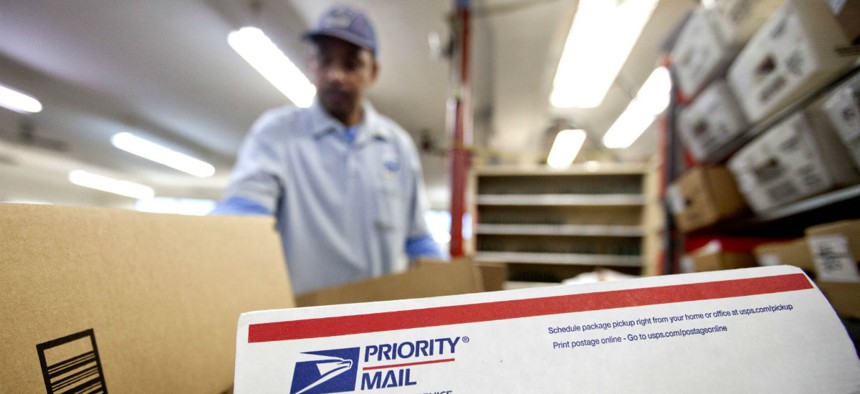
David Goldman/AP file photo
Here's How USPS Cut $10 Billion in Labor Costs Since 2006
IG says the agency is not using "sustainable strategies."
The Postal Service has cut its labor costs by more than $10 billion since fiscal 2006, a path the agency’s auditor called unsustainable in a report released Monday.
As volume has dropped precipitously, USPS has relied on trimming labor costs to account for about 75 percent of its overall reductions. When adjusting for inflation and not including the costs associated with the mandatory prefunding of future retirees health care, the Postal Service has cut 21 percent of expenditures related to its workforce over the last nine years.
The Postal Service has relied on two main tools to boost the productivity of its employees: a 3 percent uptick each year in the number of cheaper, non-career workers and cutting the number of work hours by 2.8 percent each year since 2006. All told, labor costs have dropped 2.6 percent annually over the last decade. That has not kept pace completely with the 3.5 percent reduction in mail volume over the same time period, but the USPS inspector general noted this was "primarily because of significant fixed costs in delivery."
Here are two IG charts detailing how USPS has cut labor costs, with the image on the right detailing the compound average growth rate.

The newfound reliance on non-career employees, who receive lower pay and worse benefits than their career counterparts, could prove problematic for the Postal Service going forward, the IG said. While just 1.2 percent of the agency's unionized, career workforce turns over every year -- compared to about 20 percent in the private sector -- its non-career workforce had a 29 percent quit rate in fiscal 2014.
The IG said this trend “raises the question of whether the Postal Service can continue to increase its productivity if it has to deal with training and recruiting new employees constantly. Furthermore, the impact on service quality of increased use of non-career employees is unclear.” The auditors added USPS is using “unsustainable strategies” to cut costs.
Service issues have plagued the Postal Service in recent years, as the agency has tried to match its infrastructure and operational capacity to the shrinking mail market. USPS slowed its delivery window in 2012 -- virtually eliminating overnight service -- but still missed its more lax standards for all first class delivery in fiscal 2015.
In addition to labor concerns, as well as its perhaps overly ambitious plan to shutter mail processing plants, the Postal Service could run into service issues stemming from its lack of new investments. USPS spent just $13 billion on capital expenditures from 2006 through 2014, compared to $25.5 billion by FedEx and $18.5 billion by UPS.
Still, while much has been made of the Postal Service’s repeated financial losses, the IG said 90 percent of the agency’s red ink traces back to its prefunding payments. Lawmakers for years have grappled with how to reduce the burden on the agency as it attempts to reduce its unfunded liabilities. Its overwhelming contribution to postal losses obscure the progress USPS has made in becoming more efficient, the IG said.
The Postal Service is doing better than many have given it credit for, the auditors wrote, noting the agency “has redesigned its network of processing plants, retail locations, delivery routes, and transportation systems, as well as modernized some of its workforce labor practices.”
The modernized labor practices have stemmed in part from USPS renegotiating union contracts. Those contracts have allowed the agency to replace retiring employees with both lower paid career workers and the even cheaper non-career alternative. The Postal Service is currently involved in negotiations for new collective bargaining agreements with its largest unions.
For its part, postal management took issue with the IG’s somewhat rosy conclusion the agency is in better shape than many in the community assume. USPS officials also said the auditors understated the agency's labor cost reduction by $1.6 billion.
“The Postal Service has made substantial cost reductions in response to extremely challenging financial circumstances and these actions have staved off disaster or additional defaults,” wrote Luke Grossman, vice president for finance and planning, in response to the IG’s report. “The financial challenges facing the Postal Service continue to be immense without legislative change.”







